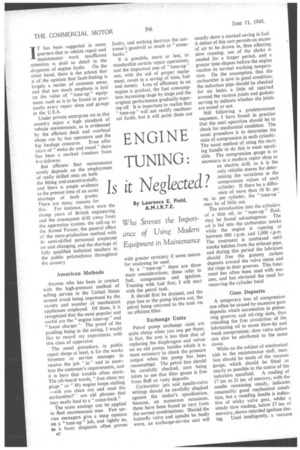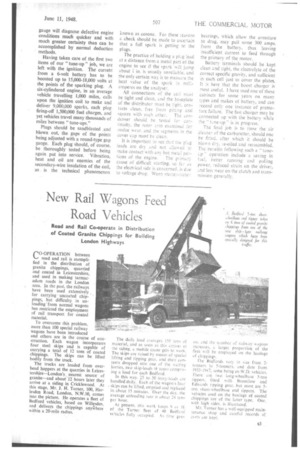ENGINE TUNING:
Page 36

Page 37

If you've noticed an error in this article please click here to report it so we can fix it.
Is it Neglected?
By Laurence E. Field, A.M.I.R.T.E.
Who Stresses the Importance of Using Modern Equipment in Maintenance I_ T has been suggested in some quarters that in vehicle repair and maintenance work insufficient attention is paid to detail in the
diagnosis of engine faults. On the other hand, there is the school that is of the opinion that fault-finding is largely a matter of common sense, and that too much emphasis is laid on the value of " tune-up " equipment. such as is to be found in practically every repair shop and garage in the U.S.A.
tinder private enterprise we in this country enjoy a high standard of vehicle maintenance, as is evidenced by the efficient dock and overhaul shops run by bus operators and the big haulage concerns. Even after ears of "make do and mend " there has been a marked freedom from bre ikdowns
But efficient fleet maintenance surely depends on the employment of really skilled men on both the fitting and executive staffs, and there is ample evidence at the present time of an acute shortage of both grades. There are many reasons for
this. For instance, there were the slump years of British engineering and the consequent drift away from the apprentice system; the call-up to the Armed Forces; the general effect of the mass-production method with its semi-skilled personnel employed on unit changing, and the shortage of fully qualified technical teachers in the public polytechnics throughout the country
Is
American Methods Anyone who has been in contact with the high-pressure method of selling service in the United States cannot avoid being impressed by the variety and number of mechanical appliances employed. Of these, it is recognized that the most popular and useful are the "engine tune-up" and "boost charger " The proof of the pudding being in the eating, I would like to record my experiences ' with this class of apparatus.
The usual procedure, in public repair shops at least, is for the works foreman or service manager to receive the job " in " and to ascertain the customer's requirements, and it is here that trouble often starts. The oft-heard words, " Just clean my plugs" or " My engine keeps stalling —will you clean out and reset the carburetter? are old phrases that may easily lead to a "come-back."
The same analogy can be applied to fleet maintenance men. Few service managers give a snap opinion on a " tune-up " job, and rightly so, as a hasty diagnosis often proves R2 faulty, and nothing destroys the customer's goodwill so much as "comebacks."
It is possible, more or lesg, to standardize certain repair operations, and the important one of " tune-up " can, with the aid of proper equipment, result in a saving of time, fuel and money. Loss of efficiency in an engine is gradual, the fuel consumption increasing stage by stage and the original performance gradually tapering off. It is important to realize that " tune-up " will not rectify mechanical faults, but it will point them out with greater certainty if some means for analysing be used.
In a " tune-up " there are three main considerations; these refer to fuel, compression and ignition. Treating with fuel first, I will start with the petrol tank.
It should first be drained, and the pipe line to the pump blown out, the petrol being returned to the tank via an efficient filter.
Exchange Units
Petrol pump exchange units are quite cheap when you can get them; in fact, the cost is less than that of replacing the diaphragms and valves on an old pump, besides which it is most necessary to check the pressure output when the pump has been reassembled. The petrol line should be carefully checked, care being taken to see that filter gauze is free from fluff or rusty deposits.
Carburetter jets and . needle-valve settings should be carefully checked against the maker's specification, because, on numerous occasions, these have been found to vary from the correct combinations. Should the butterfly valve and spindle be badly worn, an exchange-service unit will usually show a marked saving in fuel. A defect of this sort permits an excess of air to be drawn in, thus affecting slow running; use of the choke is needed for a longer period, and a greater time elapses before the engine reaches its normal working temperature. On the assumption that the carburetter is now in good condition, the induction pipe should be checked for air leaks, a little oil squirted around the various joints and gaskets serving to indicate whether the joints are sound or not.
Still following a predetermined sequence, I have found in practice that the next operation should be to check for mechanical condition. The usual procedure is to determine the state of compression in each cylinder. The usual method of using the starting handle to do this is most unreliable. The compression gauge is as necessary in a modern repair shop as an electric drill, as it is the only reliable means for determining the variations in the compression values of each cylinder. If there be a difference of more than 10 lb. per sq. in. per cylinder, the " tune-up " may be of little use.
The introduction into the cylinders of a thin oil, or " tune-up " fluid, may be found advantageous. The oil is fed into the carburetter intake while the engine is running at between 800 r.p.m. and 1,000 r.p.m. The treatment is continued until smoke belches from the exhaust pipe, and during this period the lubricant should free the gummy carbon deposits around the valve stems and the rings in their grooves. This treatment has often been used with success, and has obviated the need for removing the cylinder head Gum Deposits A temporary loss of compression can often be caused by excessive gum deposits which accumulate in pistonring grooves and oil-ring slots, thus retarding the free circulation of the lubricating oil to cause blow-by and weak compression; slow valve action can also be attributed to the same cause.
While on the subject of mechanical aids to the maintenance staff, mention should be made of the vacuum gauge, which should be fitted as nearly as possible in the centre of the
induction manifold. A reading of 17 ins, to 21 ins, of mercury, with the needle remaining steady, indicates reasonably good mechanical condition, but a receding needle is indicative of sticky valve gear, whilst a steady slow reading, below 17 ins. of mercury, shows retarded ignition tim
ing. Used intelligently, a vacuum gauge will diagnose defective engine conditions much quicker and with much greater certainty than can be accomplished by normal deduction methods.
Having taken care of the first two items of our "tune-up" job, we are left with the ignition. The curreht from a 6-volt battery has to be boosted up to 15,000-18,000 volts at the points of the sparking plug. A six-cylindered engine, in an average vehicle travelling 1,000 miles, calls upon the ignition coil to make and deliver 9,000,000 sparks, each plug firing-off 1,500,000 fuel charges, and yet vehicles travel many thousands of miles between "tune-ups."
Plugs should be sandblasted and blown out, the gaps of the points being adjusted with a round-type gap gauge. Each plug should, of course, be thoroughly tested before being again put into service. Vibration, heat and oil are enemies of the secondary-wire insulation of the coil, as . is the technical phenomenon
known as corona. For these reasons a check should be made to ascertain that a full spark is getting to the plugs.
The practice of holding a plug lead at a distance from a metal part of the engine to see if the spark will jump about. l in. is usually unreliable, and the only certain way is to measure the heat value of the spark in milliamperes on the analyser.
All connections of the coil must be tight and clean. and the baseplate of the distributor must be tight_ contacts clean, free from pitting and square with each other. The condenser shouid be tested for continuity, the rotor arm examined for undue wear. and the segments in the. cover cap must be clean.
It is important to see that the pag leads arc dry and not allowed le make contact with any hot mezal por tions of the engine. The primary cause of difficult starting, so far as the electrical side is concerned, is due to voltage drop. Worn starter-awrtor
bearings, which allow the armature to drag, may pull some 300 amps. from the batters. thus leaving insufficient current to feed through the primary of the motor..
Battery terminals should be kept clean and tight, the electrolyte of the correct specific gravity, and sufficient in each cell just to cover the plates. It is here that the boost charger is most useful. 1 have used one of these cabinets for some years on many types and makes of battery, and can record only one instance of premature failure. The fast charger may be connected up with the battery white the " tone-up " is in progress.
The final job is to rinse the air cleaner of the carburetter. should one be fitted, after which it should be blown dry, re-oiled and reassembled. The benefits following such a " tune" operation include a saving in fuel, better running and pulling power, reduced strain on the driver, less wear on the clutch and transmission generally.




















































































